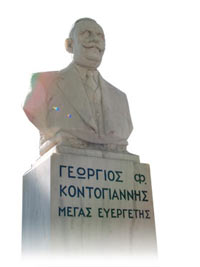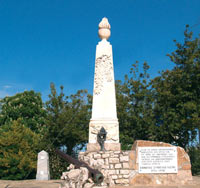Kosmas / The History of Kosmas
 In the area of Kosmas, there was the village of Selinous in antiquity. At the hill near the village there was a temple dedicated to Apollo Maleates. In the area around the village, two statuettes from the Archaic age (6th century B.C.) were found in 1871 and 1949, one of a warrior with the inscription "Harillos dedicated it to Maleates" and one of Apollo Maleates, which are now kept in the National Archeology Museum of Athens. The contribution of the village to the Revolution of 1821 was significant; 105 fighters, commanders, captains, and simple soldiers took part. The people of Kosmas participated in the war of 1897 against the Turks, in the guerrilla bands of the Macedonian struggle, in the Balkan Wars, in the Asia Minor disaster of 1922, in the expeditionary force in Russia, and in the Greek-Italian war of 1940. During the occupation by Nazi Germany and fascist Italy (1941-44), the village played a significant role again in the National Resistance, in which 58 people from Kosmas participated as regular guerrilla fighters of ELAS (Greek Popular Liberation Army) and 21 as reserves. On July 27, 1943, many guerrillas from Kosmas, together with other ELAS guerrillas from the area, fought one of the first battles in the Peloponnese against the Italian occupiers, in which the Italian governor of Tripoli, Festuccio, was killed.
In the area of Kosmas, there was the village of Selinous in antiquity. At the hill near the village there was a temple dedicated to Apollo Maleates. In the area around the village, two statuettes from the Archaic age (6th century B.C.) were found in 1871 and 1949, one of a warrior with the inscription "Harillos dedicated it to Maleates" and one of Apollo Maleates, which are now kept in the National Archeology Museum of Athens. The contribution of the village to the Revolution of 1821 was significant; 105 fighters, commanders, captains, and simple soldiers took part. The people of Kosmas participated in the war of 1897 against the Turks, in the guerrilla bands of the Macedonian struggle, in the Balkan Wars, in the Asia Minor disaster of 1922, in the expeditionary force in Russia, and in the Greek-Italian war of 1940. During the occupation by Nazi Germany and fascist Italy (1941-44), the village played a significant role again in the National Resistance, in which 58 people from Kosmas participated as regular guerrilla fighters of ELAS (Greek Popular Liberation Army) and 21 as reserves. On July 27, 1943, many guerrillas from Kosmas, together with other ELAS guerrillas from the area, fought one of the first battles in the Peloponnese against the Italian occupiers, in which the Italian governor of Tripoli, Festuccio, was killed.
 This battle took place slightly outside the village at the site known as Stavros. On January 29 to 30, 1944, the occupiers, with detachments of collaborators from Laconia, burned the village completely. Subsequently, during the years of the Civil War, the village was looted and abandoned by its inhabitants.
This battle took place slightly outside the village at the site known as Stavros. On January 29 to 30, 1944, the occupiers, with detachments of collaborators from Laconia, burned the village completely. Subsequently, during the years of the Civil War, the village was looted and abandoned by its inhabitants.
To go to Kosmas and feel the moral spirit and the meaning of this place, you don't need to know its history. The town itself is ready to teach it to you. You will find it in front of you with every step and soon you will understand that you are inside a museum whose history and glory remain fully alive.